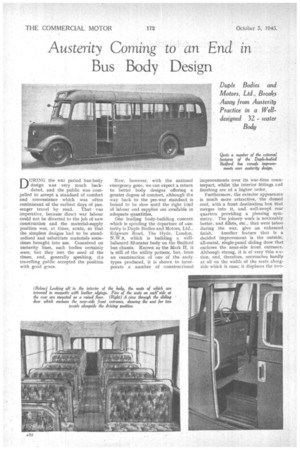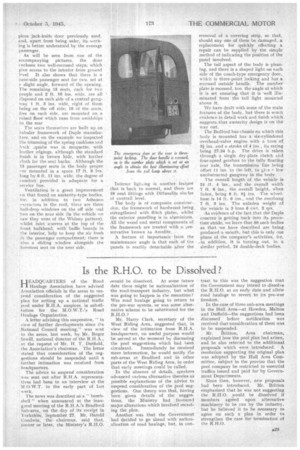Austerity Corning to an End in Bus Body Design
Page 24

Page 25

If you've noticed an error in this article please click here to report it so we can fix it.
)CRING the war period bus-body design was very much backdated, and the public was compelled to accept a standard of comfort and convenience which was often reminiscent of the earliest days of passenger travel by road. That was imperative, because direct war labour could not be diverted to the job of new construction and the material-supply position was, at times, acute, so that the simplest designs had to be standardized and substitute materials sometimes brought into use. Conceived on austerity lines, such bodies certainly were, but they met the need of the times, and, generally speaking, tbe travelling public accepted the position with good grace. Now, however, with the national emergency gone, we can expect a return to better body designs offering a greater degree of comfort, although the way back to the pre-war standard is bound to be slow until the right bind of labour and supplies are available in adequate quantities.
One leading body-building concern which is speeding the departure of austerity is Duple Bodies and Motors, Ltd., Edgware Road, The Hyde, London, N.W.9, which is building a Wellbalanced 32-seater body on the Bedford bus chassis. Known as the Mark II, it is still of the utility pattern, but, from an examination of one of the early types produced, it is shown to incorporate a number of •constructional
improvements over its war-time counterpart, whilst the interior fittings and finishing are of a higher order.
Furthermore, the exterior appearance is much more attractive, • the domed roof, with a front destination box that merges into it, and well-swept rear quarters providing a pleasing symmetry. The joinery work is noticeably better, and fillets, etc., that were taboo during the war, give an enhanced finish. Another feature that is a decided improvement is the outside, all-metal, single-panel sliding door that encloses the near-side front entrance. Although strong, it is of very thin scction, and, therefore, encroaches hardly at all on the width of the seats alongside which it runs; it displaces the two
piece jack-knife door previously used, arid, apart from being safer, its working is better understood by the average passenger.
As will be seen from . one of the accompanying pictures, the door rneloses tWo well-recessed steps; which give access to the interior from ground level It also shows that there is a near-side passenger seat for two, set at a slight angle, forward of the opening. . The remaining 15 seats, each for two people and 2 ft. 10 ins, wide, are all disposed on each side of a central gangway 1 ft. 3 ins. wide, eight of them
being on the off side; 10 of the seats,. five on each side, are moon ted on a raised floor which runs from amidships . to the rear The seats themselves are built up on tubular framework of Duple manufacj• are, and on the example we inspected t he trimming of the spring cushions and back :.rpialis was in moquette,with
leather edgings, although the standard finish is in brown hide, with leather cloth for the seat backs; Although the
15 passenger seats in the body proper are mounted in a space .17 .ft. 9 les.
long by 6 ft. .11 ins, wide, the degree of comfort provided is adequate for a service bus.
Ventilation is a great improvement in that found on austerity-type bodies, for, in addition to two Ashanco ,•-itractors in the roof, these are three half-drop 'windows on the off side -ind
two on the near side (in the vehicle we
saw they were of the Widney pattern), whilst inlet louvres -at the top of the front bulkhead, with baffle boards in the interior, help to keep the air fresh -in the passenger compartment; there is also a sliding window alongside the foremost seat On the near side:
Interior iighing is another feature that is back to normal, and there are 10 neat fittings with Diffusalite shades at cantrail level.
The body is of composite construedon, the framework. of hardwood being strengthened with flitch plates, whilst the exterior panelling is in aluminium, All the wood and metal components of the framework are treated with a preservative known as Anodite.
A feature of importance • from she maintenance angle is that each of the 'panels is readily detachable after the
removal of a covering strip, so that, should any one of them be damaged, a replacement for quickly effecting a repair can be supplied by the simple method of indicating the position of the panel involved.
The tail aspect of the body is pleasing, and there is a shaped light On each side of the coach-type emergency door, which is three-point. locking and has a recessed outside handle. The number plate is recessed, too, the angle at which it is set ensuring that it is "well iliu-minated from the tail light mounted
above it. _ •
We have dealt with some of the main features of the body, but there is much evidence in detail work and finish Which suggests -that austerity design is-on the way out.'
The Bedford bus chassis on whin this body is mounted has a six-cylindered overhead-valve engine with a bore of_ 3i .ins, and a stroke of 4 ins., its rating being 27.34 h.p. The drive is taken through a single dry-plate clutch and four-speed gearbox to the fully floating rear axle, the transmission line being Offset 11 ins. to the left, to ;Sic a lowUnobstructed gangway in the body.
The overall length of the vehicle is 24 .1t. 4 ins., and the overall width 7 ft. 6 ins., the overall height, When laden, being 8 ft. 91 ins. The wheelbase is 14 ft. 6 ins„ and the overhang 7 ft. 3 ins. The unladen weight of the vehicle is 3. tons 6 cwt. 2 qrs.
As evidence of the fact that the Duple concern is getting back into its peacetime' stride, we learn that 50 such bodies as that we have described are being produced a month, but this is only one phase of the company's activities, f(4., in addition, it is turning out, iti a similar period, 24 double-deck bodies.




















































